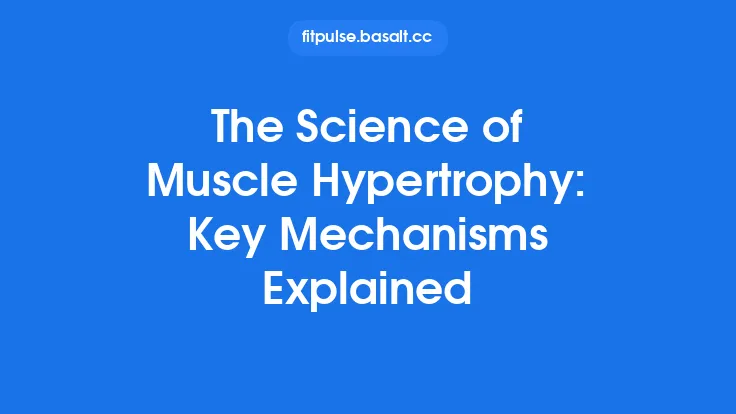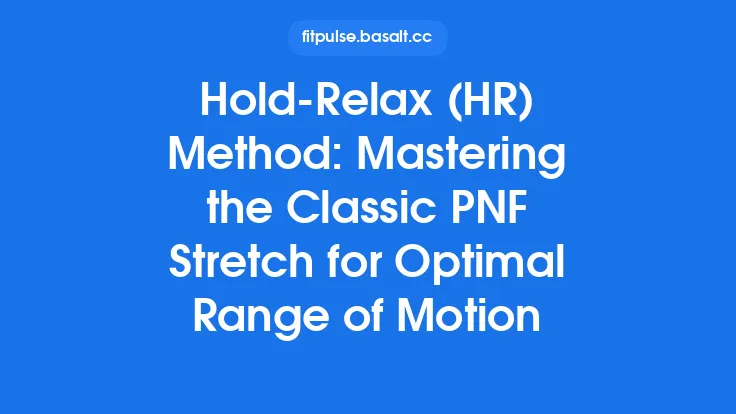Chronic pain is not merely a symptom; it is a complex neurophysiological state that can reshape the way the nervous system processes signals for the rest of a person’s life. While many traditional approaches focus on symptom relief through medication, general exercise, or lifestyle tweaks, neuromuscular strategies target the very circuitry that generates and sustains pain. By modulating the interaction between nerves, muscles, and the central nervous system, these techniques can recalibrate pain pathways, improve functional capacity, and support longevity by preserving tissue health and neural integrity.
Neuromuscular Foundations of Pain Perception
Pain begins with nociceptors—specialized sensory neurons that detect potentially damaging stimuli. When activated, they transmit electrical impulses via A‑δ (fast, sharp pain) and C‑fibers (slow, dull pain) to the dorsal horn of the spinal cord. From there, signals ascend through the spinothalamic tract to higher brain centers where they are interpreted as pain.
Two key concepts underpin neuromuscular pain modulation:
- Gate Control Theory – Proposed by Melzack and Wall, this model suggests that non‑painful input (e.g., touch, vibration) can “close the gate” on nociceptive transmission. Large‑diameter afferents (A‑β fibers) inhibit the transmission of pain signals by activating inhibitory interneurons in the dorsal horn.
- Descending Inhibitory Pathways – The brain can send modulatory signals down the spinal cord via serotonergic, noradrenergic, and endogenous opioid pathways. When these pathways are robust, they dampen nociceptive input; when they are compromised (as often occurs with chronic pain), the gate remains open, amplifying pain perception.
Understanding these mechanisms is essential because neuromuscular interventions are designed to enhance the gate‑closing effect and strengthen descending inhibition, thereby reducing the central amplification that characterizes chronic pain.
Central and Peripheral Modulation Pathways
Peripheral Sensitization occurs when nociceptors become hyper‑responsive due to inflammation, tissue injury, or repeated activation. This leads to a lowered threshold for pain and an exaggerated response to normally innocuous stimuli (allodynia).
Central Sensitization is a more entrenched phenomenon where neurons in the dorsal horn and higher centers become hyper‑excitable. Persistent peripheral input can cause long‑term changes in synaptic strength (LTP‑like processes), resulting in pain that persists even after the original tissue injury has healed.
Neuromuscular approaches aim to intervene at both levels:
- Peripheral Level – By delivering targeted electrical or mechanical stimuli, we can directly modulate nociceptor activity, reduce inflammatory mediators, and promote healthy afferent signaling.
- Central Level – Repetitive, patterned neuromuscular input can drive neuroplastic changes that restore normal excitability in spinal and supraspinal circuits, re‑establishing effective descending inhibition.
Electrical Neuromodulation Techniques
Electrical stimulation has become a cornerstone of neuromuscular pain management. The following modalities differ in waveform, intensity, and depth of penetration, each offering distinct therapeutic benefits.
| Modality | Typical Parameters | Primary Mechanism | Clinical Insight |
|---|---|---|---|
| Transcutaneous Electrical Nerve Stimulation (TENS) | 1–200 Hz, pulse width 50–200 µs, intensity just below motor threshold | Activates A‑β fibers → gate closure; may trigger endogenous opioids at higher frequencies | Best for superficial, localized pain; portable units enable home use |
| Percutaneous Electrical Nerve Stimulation (PENS) | 2–10 Hz, longer pulse widths, needle electrodes placed near peripheral nerves | Direct stimulation of mixed nerves → stronger gate effect and deeper analgesia | Useful for deep musculoskeletal pain where surface TENS is insufficient |
| Spinal Cord Stimulation (SCS) | 40–60 Hz (conventional) or 1 kHz (high‑frequency), implanted leads over dorsal columns | Alters dorsal column processing, reduces hyper‑excitability of dorsal horn neurons | Indicated for refractory neuropathic pain; long‑term studies show durability |
| Peripheral Nerve Stimulation (PNS) | 10–100 Hz, percutaneous leads adjacent to target nerve | Localized inhibition of nociceptive transmission; can be combined with motor recruitment | Emerging evidence for chronic shoulder and knee pain |
| Functional Electrical Stimulation (FES) | 20–50 Hz, pulse width 200–400 µs, intensity to elicit muscle contraction | Simultaneous motor activation and sensory input → synergistic gate closure and muscle conditioning | Particularly valuable for age‑related sarcopenia coupled with pain |
Key considerations for clinicians include electrode placement precision, patient tolerance, and the need for individualized dosing protocols. Evidence suggests that intermittent, high‑intensity bursts (e.g., “burst TENS”) may produce longer‑lasting analgesia by engaging both peripheral and central mechanisms.
Targeted Motor Control Retraining
Motor control deficits are common in chronic pain states; altered recruitment patterns can perpetuate abnormal loading and maintain nociceptive input. Neuromuscular retraining focuses on re‑establishing optimal activation sequences without relying on traditional strength training.
- EMG‑Guided Biofeedback – Surface electromyography provides real‑time visual or auditory cues about muscle activation. By training patients to selectively activate deep stabilizers (e.g., multifidus, transversus abdominis) while inhibiting overactive superficial muscles, the nervous system learns a new, less painful motor pattern.
- Task‑Specific Neuromuscular Re‑education – Instead of generic exercises, patients practice functional tasks (e.g., reaching, stepping) under controlled conditions that emphasize correct timing and coordination. The use of motion capture or inertial sensors can quantify kinematic errors and guide progressive adjustments.
- Motor Imagery and Action Observation – Mental rehearsal of movement activates similar cortical networks as actual execution. When combined with peripheral stimulation, motor imagery can potentiate neuroplastic changes, enhancing the efficacy of physical retraining.
These strategies are particularly relevant for older adults, where preserving fine motor coordination can reduce fall risk and maintain independence, thereby contributing to longevity.
Proprioceptive Enhancement Strategies
Proprioception—the sense of body position and movement—relies on muscle spindles, Golgi tendon organs, and joint mechanoreceptors. Chronic pain often blunts proprioceptive acuity, leading to maladaptive movement patterns and further tissue stress.
- Joint Position Sense Training – Using devices such as isokinetic dynamometers or portable goniometers, patients receive feedback on joint angle errors. Repeated practice sharpens spindle sensitivity and improves central integration of proprioceptive signals.
- Sensory‑Enriched Surfaces – Balance boards, wobble cushions, and textured mats provide unpredictable perturbations that challenge the proprioceptive system. While these tools are sometimes classified under “balance training,” the emphasis here is on sensory recalibration rather than strength or endurance.
- Vibration‑Induced Muscle Spindle Activation – Low‑frequency vibration (30–80 Hz) applied to tendons or muscle bellies can temporarily increase spindle firing rates, enhancing proprioceptive feedback loops. Repeated sessions have been shown to reduce pain perception by reinforcing the gate‑closing effect of robust afferent input.
By restoring accurate proprioceptive signaling, the nervous system can better differentiate between harmful and benign stimuli, reducing the likelihood of chronic pain amplification.
Vibration and Mechanical Stimulation
Beyond proprioceptive training, vibration itself serves as a potent neuromodulatory tool. Two primary mechanisms are at play:
- Mechanotransduction – Mechanical oscillations convert physical energy into biochemical signals within muscle fibers and connective tissue, influencing ion channel activity and reducing inflammatory cytokine production.
- Neuromodulatory Gate Activation – Vibratory input preferentially stimulates large‑diameter A‑β fibers, reinforcing the gate control mechanism. When applied at therapeutic intensities (often 1–2 mm displacement, 30–100 Hz), vibration can produce immediate analgesia lasting up to an hour.
Clinical devices range from handheld vibrators for localized treatment to whole‑body vibration platforms that deliver low‑magnitude, high‑frequency oscillations to the entire musculoskeletal system. While whole‑body vibration has been explored for bone health, its analgesic benefits stem from systemic activation of proprioceptive pathways and enhanced circulation, which together support tissue repair and pain reduction.
Integrating Neuromuscular Approaches into Longevity Protocols
For a neuromuscular regimen to contribute meaningfully to longevity, it must be woven into a broader health strategy that respects the aging body’s unique physiology.
- Periodization of Neuromodulation – Just as training cycles prevent overuse, alternating periods of high‑intensity electrical stimulation with low‑intensity maintenance phases can avoid neural habituation and preserve analgesic efficacy.
- Synergy with Nutritional Support – Adequate intake of omega‑3 fatty acids, magnesium, and vitamin D supports neuronal membrane health and may amplify the benefits of neuromuscular interventions.
- Monitoring Neural Plasticity – While the article avoids detailed metrics, clinicians can employ simple functional assessments (e.g., pain pressure thresholds, gait symmetry) to gauge neuroplastic changes over time, adjusting protocols accordingly.
- Personalized Dose‑Response Mapping – Using wearable EMG or accelerometer data, practitioners can identify the minimal effective dose of stimulation that yields pain relief without causing fatigue or discomfort, a principle especially important for older adults with reduced recovery capacity.
- Education and Self‑Management – Empowering patients to operate portable TENS units, perform proprioceptive drills, or engage in motor imagery fosters autonomy, reduces reliance on healthcare visits, and sustains long‑term adherence—key factors in healthy aging.
Future Directions and Emerging Technologies
The field of neuromuscular pain modulation is rapidly evolving, with several promising avenues that could reshape chronic pain management for the next generation.
- Closed‑Loop Neuromodulation – Systems that continuously monitor neural activity (e.g., via implanted micro‑electrodes) and adjust stimulation parameters in real time are under development. Such feedback‑driven devices could maintain optimal gate closure without manual reprogramming.
- High‑Definition Transcranial Direct Current Stimulation (HD‑tDCS) – By targeting cortical regions involved in pain perception (e.g., primary somatosensory cortex, anterior cingulate), HD‑tDCS may complement peripheral neuromuscular strategies, reinforcing descending inhibition.
- Artificial Intelligence‑Guided Protocol Optimization – Machine‑learning algorithms can analyze large datasets of patient responses to various stimulation patterns, recommending individualized protocols that maximize analgesia while minimizing side effects.
- Hybrid Biofeedback Platforms – Combining EMG, force plate, and heart‑rate variability data into a single interface allows simultaneous training of motor control, proprioception, and autonomic regulation—an integrated approach that aligns with the multifactorial nature of chronic pain.
- Nanotechnological Delivery of Neuromodulators – Emerging research on nanoparticle‑encapsulated neurotrophic factors aims to enhance peripheral nerve health, potentially augmenting the effects of electrical stimulation by promoting nerve regeneration.
As these technologies mature, they will likely converge into comprehensive, patient‑centric platforms that deliver precise, adaptable neuromuscular interventions—transforming chronic pain from a lifelong burden into a manageable, reversible condition.
By focusing on the neurophysiological underpinnings of pain and leveraging targeted neuromuscular tools, practitioners can not only alleviate suffering but also preserve functional capacity, support tissue health, and promote longevity. The science of pain modulation is a dynamic intersection of electrophysiology, biomechanics, and neuroplasticity; mastering it equips clinicians and individuals alike with a powerful means to sustain vitality well into the later decades of life.





